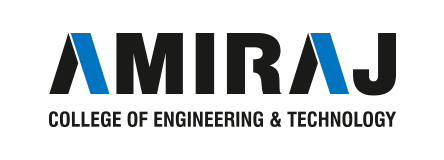Waste Management Plan for Village Tintoda
By the year 2025, 83 per cent of the expected global population of 8.5 billion will be living in developing countries. Yet the capacity of available resources and technologies to satisfy the demands of this growing population for food and other agricultural commodities remains uncertain.
Unsustainable patterns of production and consumption are increasing the quantities and variety of environmentally persistent wastes at unprecedented rates. The trend could significantly increase the quantities of wastes produced by the end of the century and increase quantities four to fivefold by the year 2025. A preventive waste management approach focused on changes in lifestyles and in production and consumption patterns offers the best chance for reversing current trends.
A transformation of the global energy system is needed to provide sustainable energy for all, to satisfy rapid growth in energy demand, particularly in developing countries, and to diminish the negative impacts of climate change. New and renewable sources of energy stand at the center of global efforts to induce a paradigm shift towards green economies, poverty eradication and ultimately sustainable development. Record investments are being made by some countries to propel innovation, development and commercialization of renewable energy technologies. Nevertheless, much more cooperation and action is needed to substantially increase the contribution of these technologies to the global energy system. A coordinated global energy strategy needs to be adopted, in conjunction with consistent and stable national policies, to bring down the cost of renewable energy technologies, including off-grid systems, for use by the poorest segments of the population living in rural areas.
Above statements of UN clearly reflect the need for genuine and organized initiatives in the rural waste management in India. With the emerging concern on large quantity of waste being produced both in the form of solid and liquid waste, the concept of waste management becomes one of the key focus of sustainable development principles which is based on policies, and practices that are resource- conversing, follow standards that can be met in the long term, and respect values of equity in human access to resources. Defining Solid and Liquid Waste Management (SLWM) is the collection, transport, processing, recycling or disposal of waste materials, usually ones produced by human activity, in an effort to reduce their effect on human health or local aesthetics and more often, to replace conventional energy resources which are exhaustible and an obvious threat to environment.
Villages are actually strength of the country but illiteracy of the habitats and avoidance of the rural issues by other end of the Indian society are the very reasons that convert the strength in to weakness on exponential scale. The major concern is improper and unplanned waste management system. In fact, our villages are extremely rich in biomass. Non conventional energy sources are actually now no more “Non conventional”, as those have gained very good degree of popularity, still the appropriate and efficient implementation of any such system is challenging.
ECOSYSTEM OF VILLAGE TINTODA
The Planning Area
Regional Profile with Location Map:
| Place : | Tintoda |
| PIN Code | 382422 |
| District : | Gandhinagar |
| Tehsil/Taluka : | Gandhinagar |
| State : | Gujarat |
| Latitude | 23.21271 |
| Longitude | 72.57291 |
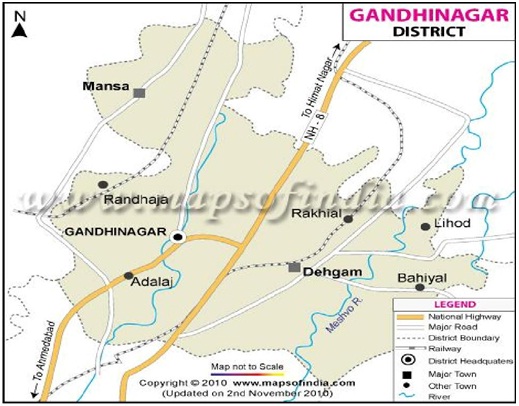
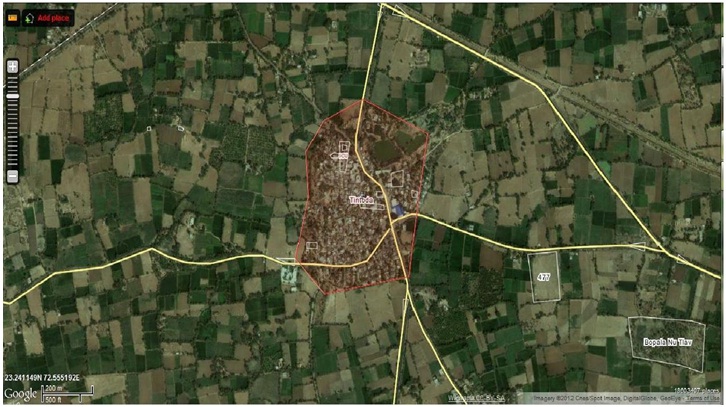
Map of Village Tintoda- situated at 11 kms from Gandhinagar, 7 Kms from Kalol & 3 Kms from Shertha
General:
The history seems to be associated with Rabari caste. There is “Vadwala Temple” in the village, which has religious importance for Rabaris. Also the occupation of cattle rearing is dominant in the village which is very common for Rabari caste. A Shwetambar jain tample is also located in the village which is considered as one of the important “Tirthas” of Jain religion. The village is divided in to various Parts traditionally known as “vaas”, like Kumbharvaas, Thhakorvaas, Darjivaas, Ravaliyavaas etc. It is observed that basically the division might be based on group of habitats belonging to same caste, but presently the trend is not followed.
Village Profile:
| Area details | |
|---|---|
| Area of village (in hectares) | 990.59 |
| Number of households | 1,261 |
| Population data based on 2001 census | |
|---|---|
| Total population – Persons | 6,593 |
| Total population – Males | 3,378 |
| Total population – Females | 3,215 |
| Scheduled castes population – Persons | 102 |
| Scheduled castes population – Males | 52 |
| Scheduled castes population – Females | 50 |
| Scheduled tribes population – Persons | 2 |
| Scheduled tribes population – Males | 1 |
| Scheduled tribes population – Females | 1 |
| Education facilities | |
|---|---|
| Education facilities | Available |
| Number of primary schools | 6 |
| Number of middle schools | 0 |
| Number of secondary schools | 1 |
| Number of senior secondary schools | 0 |
| Number of colleges | 0 |
| College available within range | More than 10 Kms |
| Number of adult literacy class/centres | 0 |
| Number of industrial schools | 0 |
| Number of training schools | 0 |
| Number of other educational schools | 0 |
| Medical facilities | |
|---|---|
| Medical facilities | Available |
| Number of allopathic hospitals | 0 |
| Allopathic hospitals available within range | More than 10 Kms |
| Number of ayurvedic hospitals | 0 |
| Number of unani hospital | 0 |
| Number of homeopathic hospital | 0 |
| Number of allopathic dispensary | 0 |
| Number of ayurvedic dispensary | 0 |
| Number of unani dispensary | 0 |
| Number of homeopathic dispensary | 0 |
| Number of maternity and child welfare centre | 1 |
| Number of maternity home | – |
| Number of child welfare centre | 0 |
| Number of health centre | 0 |
| Number of primary health centre | 0 |
| Primary health centre available within range | Between 5 Kms and 10 Kms |
| Number of primary health sub centre | 1 |
| Number of family welfare centre | 0 |
| Number of T.B. clinic | 0 |
| Number of nursing home | 0 |
| Number of registered private medical practiotioners | 0 |
| Number of subsidised medical practitioners | 0 |
| Number of community health workers | 1 |
| Number of other medical facilities | 0 |
| Drinking water facilities | |
|---|---|
| Drinking water facilities | Available |
| Tap water | Available |
| Well water | Not Available |
| Tank water | Available |
| Tubewell water | Available |
| Handpump | Not Available |
| River water | Not Available |
| Canals | Not Available |
| Lakes | Not Available |
| Spring | Not Available |
| Other drinking water sources | Not Available |
| Post, telegraph and telephone facilities | |
|---|---|
| Post, telegraph and phone facilities | Available |
| Number of post office | 1 |
| Number of telegraph office | 0 |
| Number of post and telegraph office | 0 |
| Number of telephone connections | 10 |
| Communication facilities | |
|---|---|
| Communication facilities | Yes |
| Bus services | Yes |
| Railways services | Yes |
| Navigable water way including river, canal etc. | No |
| Banking facilities | |
|---|---|
| Banking facilities | Not available |
| Number of commercial bank | 0 |
| Commercial bank available within range | Between 5 Kms and 10 Kms |
| Number of Co-operative commercial bank | 0 |
| Co-operative bank available within range | More than 10 Kms |
| Credit societies | |
|---|---|
| Credit societies facilities | Available |
| Number of agricultural credit societies | 1 |
| Number of non agricultural credit societies | 0 |
| Available within range | More than 10 Kms |
| Number of other credit societies | 0 |
| Other credit societies available within range | More than 10 Kms |
| Recreational and cultural facilities | |
|---|---|
| Recreational and cultural facilities | Not available |
| Number of cinema/video-hall | 0 |
| Cinema / video-hall available within range | More than 10 Kms |
| Number of sports club | 0 |
| Sports club available range | More than 10 Kms |
| Number of stadium/auditorium | 0 |
| Stadium /auditorium available within range | More than 10 Kms |
| Approach to villages | |
|---|---|
| Approach paved roads | Available |
| Approach mud roads | Not available |
| Approach foot path | Available |
| Approach – navigable river | Not available |
| Approach – navigable canal | Not available |
| Approach – navigable water-way other than river or canal | Not available |
| Nearest town | GANDHINAGAR |
| Distance from the nearest town (in kilometer(s)) | 12 |
| Power supply | |
|---|---|
| Power supply facilities | Available |
| Electricity for domestic use | Available |
| Electricity of agricultural use | Available |
| Electricity of other purposes | Available |
| Electricity for all purposes | Available |
| News paper/magazine | |
|---|---|
| News paper/magazine facilities | Available |
| Newspaper | Available |
| Magazine | Available |
| Income and expenditure of the village (in Rs.’00) | |
|---|---|
| Income & Expenditure of the village | Yes |
| Total income | 10366 |
| Total expenditure | 6505 |
| Most important commodities manufactured | |
|---|---|
| Manufactured item no. 1 | BAJRI |
| Manufactured item no. 2 | CASTOR SEEDS |
| Manufactured item no. 3 | PADDY |
| Land use (Two decimal) in hectares | |
|---|---|
| Number of forest land | 0 |
| Number of government canal | 0 |
| Number of private canal | 0.00 |
| Well(with/without electricity) | 0.00 |
| Tube-well (without electricity) | 0.00 |
| Tube-well (with electricity) | 374.68 |
| Tank | 0.00 |
| River | 0.00 |
| Lake | 0.00 |
| Waterfall | 0.00 |
| Total irrigated area | 374.68 |
| Unirrigated area | 358.88 |
| Culturable waste (including gauchar and groves) | 87.92 |
| Area not available for cultivation | 169.11 |
Occupation and Economical Conditions:
Across all 1261 households of the village, the dominant occupation is agriculture and cattle rearing. There are very few small glossary shops. Among total population 45% people are main workers for generating income source for their family. Total 211 families live below poverty line. (socio-economic review- commissionerate of Rural development- Govt of Gujarat). On physical visit, it is very clear that number of actual BPL families must be even high. Most people dwell in raw houses.
Education:
Literacy level of the village
| Total Population | Literate | Illiterate | |
| Persons | 6593 | 4019 | 2574 |
| Male | 3378 | 2437 | 941 |
| Female | 3215 | 1582 | 1633 |
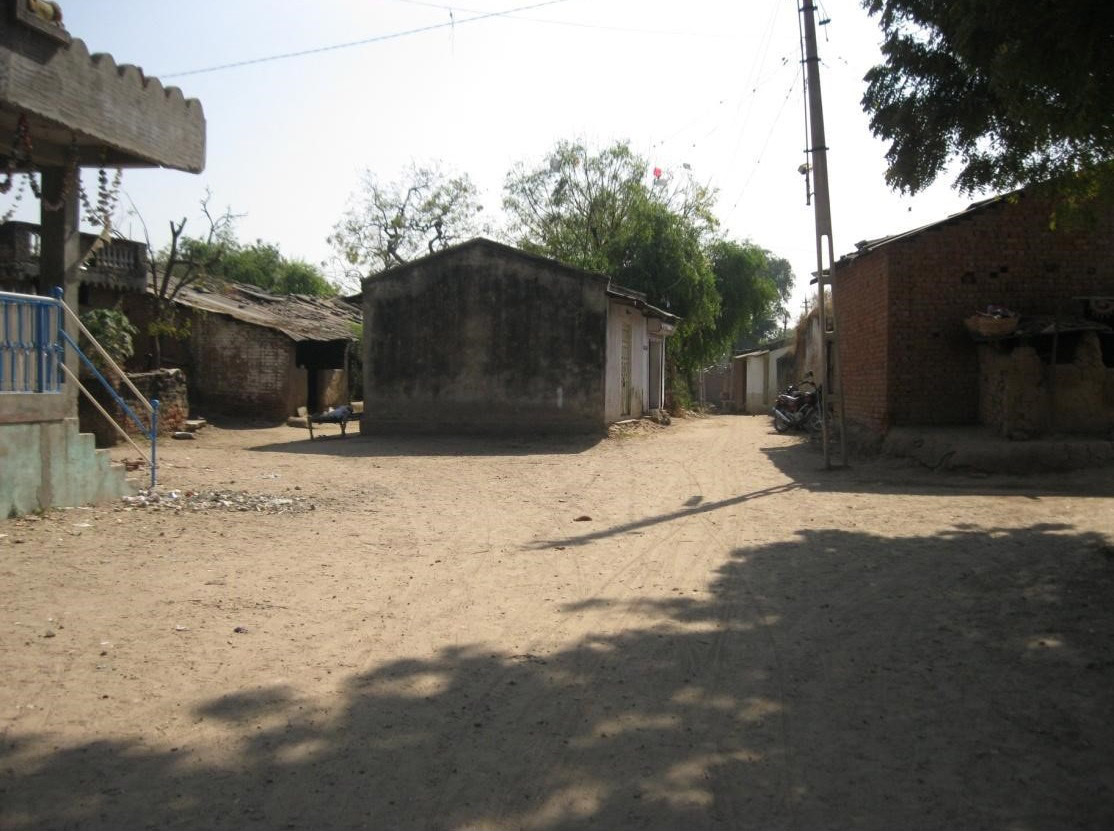

Housing pattern of village Tintoda
Land Distribution:
| Sr. No. | Details | Area in hectares |
| 1 | A. Cultivable Land i) Old Agreement ii) New Agreement B. Land on Free Hold Others Block A Total |
794.3085 5.9794 1.3051 2.9845 0.5362 805.1137 |
| 2 | B-1 : Non-Cultivable Land | 13.2532 |
| 3 | B-2 : Community Utility 1. Gaamtal 2.Gochar 3.Lake 4.Railway Track 5.Local Board Road 6.Kutcha Roads 7.Toileteries 8. Others |
26.0012 87.9783 16.6631 03.4803 8.5038 4.0569 2.8935 19.5259 |
| 169.1196 | ||
| 4 | C- others registered | 3.0873 |
| B-2 + C= | 172.2169 | |
| B-1+B-2+C= | 185.4701 | |
| 5 | TOTAL | 990.5838 |
Agriculture and crop pattern
Village Tintoda owns 805.1137 hectares cultivable land area. Effective irrigated land area is 374.68 hectares. Following table represents typical cropping pattern and annual crop yield. As it is shown, cotton, castor, paddy and vegetables are the major crops in village agriculture.
Crop yield- village Tintoda
| Sr. No. | Season | Crop | Area-hectare | Yield in quintal/hac |
| 1 | Kharif | Cotton | 150 | 25 |
| 2 | Castor | 50 | 15 | |
| 3 | Paddy | 20 | 30 | |
| 4 | Chilies | 20 | 100 | |
| 5 | Others | 10 | 150 | |
| Total | 250 | |||
| 6 | Rabi | Bhinda | 70 | 250 |
| 7 | Cauliflower | 30 | 300 | |
| 8 | Potato | 30 | 300 | |
| 9 | Bringal | 20 | 175 | |
| 10 | Cabbage | 70 | 370 | |
| 11 | Others | 30 | 100 | |
| Total | 250 | |||
| 12 | Zaid | Bhinda | 100 | 200 |
| 13 | Cabbage | 70 | 295 | |
| 14 | Cauliflower | 30 | 250 | |
| 15 | Others | 50 | 275 | |
| Total | 250 |
Environmental conditions:
Water Rainfall: Rainfall data: Gandhinagar Taluka
| Year | 2001 | 2002 | 2003 | 2004 | 2005 | 2006 | 2007 | 2008 | 2009 | 2010 | 2011 |
| Rainfall in mm | 421 | 373 | 1031 | 806 | 1254 | 1133 | 1126 | 802 | 586 | NA | NA |
Ground water: Water samples were collected from bore wells of forty villages of Gandhinagar taluka during May-2006. Ten villages of each region of Gandhinagar taluka (North, South, East and West) were selected for water sampling. Tintoda was considered as one of ten selected villages of west region of Gandhinagar10. Drinking water is supplied through pipelines from panchayat’s tube well, which cover almost the whole area.
Quality of ground water – village Tintoda
| Parameter | pH | EC | TDS | TA | CaH | MgH | TH | Cl– | F– | Na+ | K+ | DO | BOD | COD | SO4 2– |
| WHO Std. | 6.5 – 8.5 |
1.4 | 10 00 |
120 | 10 0 |
150 | 50 0 |
250 | 1.5 | 20 0 |
– | >5 | 5 | 10 | 500 |
| Exp. Value | 7.2 6- 8.0 6 |
0.69 5- 1.89 |
30 1- 80 6 |
344 – 112 2 |
60 – 18 0 |
12- 128 |
72 – 24 0 |
86.2 7- 592. 99 |
0.5 – 2.3 5 |
14 9- 60 00 |
1. 0- 2. 0 |
4.4 5- 7.9 0 |
0.4 – 3.6 5 |
0.8 – 4.0 |
12.8 7- 62.5 4 |
| Ave. value | 7.4 1 |
1.16 | 49 4 |
652 .4 |
90. 4 |
68. 8 |
15 9 |
276. 9 |
0.8 7 |
27 32 |
1. 2 |
6.0 6 |
1.0 9 |
1.5 2 |
30.5 2 |
Values of all parameters are in mg/L except pH and EC (mS/cm)
Solid and liquid waste:
To determine the picture of waste generation and management, household inventories were conducted. 45 families from different areas of the village were interviewed. Questionnaire was prepared based upon environmental management aspects to get a broader outline about current waste management practices. Following table gives a general idea of present scenario of waste generation and management.
House hold inventory- village Tintoda
| 1 | 2 | 3 | 4 | 5 | |
| Name | Kesarben Mahorji |
Thhakor Manajibhai |
Prhaladji Kalaji |
Lilaben Gandaji |
Ranjanben |
| Address | Juno Kumbharvaas |
Juno Kumbharvaas |
Juno Kumbharvaas |
Juno Kumbharvaas |
Targala wado |
| Caste | Thhakore | Thhakore | Thhakore | Thhakore | Thhakore |
| Family Members |
5 | 9 | 6 | 4 | 9 |
| Education | L – 0 IL – 5 | L- 5 IL – 4 | L- 3 IL – 3 | IL 4 | L-3 IL-6 |
| Source of Income |
Labour | Farmer | Farmer | Labour | Farmer |
| Health situation |
—- | Frequent fever |
— | T.B. | |
| No. of cattle | 2- Buffalo | 3- Buffalo | 3- Buffalo | 2- Buffalo | 2- Buffalo |
| Domestic waste |
No | Yes | Yes | Yes | Yes |
| Others | sometimes | Cattle dung | Cattle dung | Cattle dung | Cattle dung |
| Waste Disposal |
Random | Common place/farm |
Common place/farm |
Common place/farm |
Random |
| Water Supply | Yes | Yes | Yes | Yes | Yes |
| Sanitation | No- open | No- open | No- open | No- open | No- open |
| Views about Sanitation: Private/public |
Public | Public | Public | Private | Private |
| Cooking aid | Chulha | Chulha | Chulha | Chulha/LPG | Chulha |
| Views-Biogas | Yes | Yes | Yes | Yes | Yes |
| 6 | 7 | 8 | 9 | 10 | |
| Name | Goswami Bhaveshbhai |
Shambhuji Bhikhaji |
Rameshji Ishwarji |
Keshiben Gandaji |
Champaben Gandabhai |
| Address | Mahadev Temple |
Nayakwado | Nayakwado | Vaniyavaas Sarpanch |
Motovaas |
| Caste | Goswami | Thhakore | Thhakore | Thhakore | Panchal |
| Family Members |
5 | 4 | 6 | 18 | 6 |
| Education | L- 5 | IL – 4 | L- 3 IL -3 | L-6 IL-12 | L-2 IL-4 |
| Source of Income |
Pujari | Labour | Labour | Glossary shop, farmer |
Labour |
| Health situation |
— | Fever fever |
— | — | — |
| No. of cattle | 2- Buffalo | — | — | 3- Buffalo | 1- Buffalo |
| Food/kitchen | Yes | Yes | Yes | Yes | Yes |
| Others | Cattle dung | —– | —– | Cattle dung | Cattle dung |
| Waste Disposal |
Common place |
Common place |
Common place |
Common place/farm |
Common place/farm |
| Water Supply | Yes | Yes | Yes | Yes | Yes |
| Sanitation | Yes | No | No | Yes | Yes |
| Views about Sanitation: Private/public |
— | — | Public | — | Public |
| Cooking aid | LPG | Chulha | Chulha | Chulha/LPG | Culha/stove |
| Views-Biogas | Yes | Yes | Yes | Yes | Yes |
| 11 | 12 | 13 | 14 | 15 | |
| Name | Savitaben | Bhalajibhai Ambaram |
Navneetkumar Natvarlal |
Kalyanjibhai Chandas |
Kokilaben Purushottam |
| Address | Thhakore vaas |
Darjivaas | Darjivaas | Darjivaas | Darjivaas |
| Caste | Thhakore | Parekh | Darji | Darji | Nayee |
| Family Members |
6 | 2 | 5 | 3 | 2 |
| Education | IL – 6 | IL – 2 | IL – 5 | IL – 3 | L – 2 |
| Source of Income |
Labour | Nayee | Tailoring | Tailoring | Job-retired |
| Health situation |
—— | —— | —— | —— | —— |
| No. of cattle | 3- Buffalo | —— | —— | —— | —— |
| Food/kitchen | Yes | Yes | Yes | Yes | Yes |
| Others | Cattle dung | —— | —— | —— | —— |
| Waste Disposal |
Random/farm | Common place |
Random | Random | Random |
| Water Supply | Yes | Yes | Yes | Yes | Yes |
| Sanitation | No | Yes | Yes | Yes | Yes |
| Views about Sanitation: Private/public |
Private | —- | —- | —- | —- |
| Cooking aid | Chulha | Chulha | LPG | LPG | LPG |
| Views-Biogas | Yes | Yes | Yes | Yes | Yes |
| 16 | 17 | 18 | 19 | 20 | |
| Name | Sodaji Mangaji |
Amrutji Kalaji |
Kalaji Bhalaji |
Shantaben | Manisha Joshi |
| Address | Darjivaas | Darjivaas | Darjivaas | Brhamanvado | Brhamanvado |
| Caste | Thhakore | Thhakore | Thhakore | Prajapati | Brahmin |
| Family Members |
2 | 4 | 6 | 12 | 6 |
| Education | IL – 2 | L- 2 IL -2 | L- 1 IL -5 | L- 3 IL – 9 | L-5 IL-6 |
| Source of Income |
Farmer | Farmer | Labour | shop | Job |
| Health situation |
—— | —— | Fever | Fever | —— |
| No. of cattle | —— | 2- Buffalo | —– | —– | —– |
| Food/kitchen | Yes | Yes | Yes | Yes | Yes |
| Others | —– | Cattle dung | —– | —– | —– |
| Waste Disposal |
Random | Random/farm | Random | Common Place |
Common Place |
| Water Supply | Yes | Yes | Yes | Yes | Yes |
| Sanitation | Yes | Yes | Yes | Yes | Yes |
| Views about Sanitation: Private/public |
— | — | Private | Public | —– |
| Cooking aid | Chulha | LPG/Chulha | Chulha | Chulha/LPG | LPG |
| Views-Biogas | Yes | Yes | Yes | Yes | Yes |
| 21 | 22 | 23 | 24 | 25 | |
| Name | Girdharbhai prajapati |
Kamuben Prajapati |
Savitaben | Bhikhiben Thhakore |
Vihajibhai |
| Address | Brahman vado |
Brahman vado |
Brahman vado |
Brahman vado |
Mandirvalo vaas |
| Caste | Prajapati | Prajapati | Thhakore | Thhakore | Thhakore |
| Family Members |
5 | 3 | 12 | 10 | 10 |
| Education | L – 1 IL – 4 | IL – 3 | IL – 12 | IL – 10 | IL – 10 |
| Source of Income |
Farmer | Vendor | Labour | Labour | Farmer |
| Health situation |
—— | —— | —— | —— | —— |
| No. of cattle | 1- Buffalo | —– | —– | —– | 4- Buffalo |
| Food/kitchen | Yes | Yes | Yes | Yes | Yes |
| Others | Cattle dung | —– | —– | —– | Cattle dung |
| Waste Disposal |
Random | Random | Random | Random | Random/Farm |
| Water Supply | Yes | Yes | Yes | Yes | Yes |
| Sanitation | No | No | Yes | No | No |
| Views about Sanitation: Private/public |
Private | Private | —– | Private | —– |
| Cooking aid | LPG | LPG/Chulha | Chulha | Chulha | Chulha |
| Views-Biogas | Yes | Yes | Yes | Yes | Yes |
| 26 | 27 | 28 | 29 | 30 | |
| Name | Jigneshbhai | Jashiben | Prhladbhai | Bhaveshbhai | Jivanbhai Karshanbhai |
| Address | Mandirvalo vaas |
Mandirvalo vaas |
Mandirvalo vaas |
Prajapati vaas |
Rawal vaas |
| Caste | Thhakore | Thhakore | Thhakore | —– | Raval |
| Family Members |
20 | 5 | 7 | 12 | 9 |
| Education | L -9 IL – 11 | IL – 5 | IL – 7 | L – 4 IL – 8 | IL – 9 |
| Source of Income |
Shop, farmer | Labour | Labour | Shop | Labour |
| Health situation |
—— | —— | —— | —— | —— |
| No. of cattle | 10- Buffalo | —– | 3- Buffalo | —– | —– |
| Food/kitchen | Yes | Yes | Yes | Yes | Yes |
| Others | Cattle dung | —– | Cattle dung | —– | —– |
| Waste Disposal |
Random/farm | Random | Random | Random | Random/Farm |
| Water Supply | Yes | Yes | Yes | Yes | Yes |
| Sanitation | Yes | No | Yes | Yes | No |
| Views about Sanitation: Private/public |
—– | —– | —– | —– | —– |
| Cooking aid | LPG | Chulha | Chulha | Chulha | Chulha |
| Views-Biogas | Yes | —– | Yes | Yes | Yes |
| 31 | 32 | 33 | 34 | 35 | |
| Name | Champaben | Bhikhiben | Mathurbhai | Maheshbhai | Haribhai Ghelabhai |
| Address | Rawal vaas | Rawal vaas | Rawal vaas | Rawal vaas | Rawal vaas |
| Caste | Rawal | Rawal | Rawal | Rawal | Rawal |
| Family Members |
2 | 4 | 4 | 2 | 7 |
| Education | IL – 2 | IL – 4 | IL – 4 | IL – 2 | IL – 7 |
| Source of Income |
Labour | Labour | —– | Labour | Labour |
| Health situation |
—— | —— | —— | —— | —— |
| No. of cattle | —– | —– | —– | —– | —– |
| Food/kitchen | —– | —– | —– | —– | —– |
| Others | —– | —– | —– | —– | —– |
| Waste Disposal |
—– | —– | —– | —– | —– |
| Water Supply | Yes | Yes | Yes | Yes | Yes |
| Sanitation | No | No | Yes | No | No |
| Views about Sanitation: Private/public |
—– | —– | —– | —– | Public |
| Cooking aid | Chulha | Chulha | Chulha | Chulha | Chulha |
| Views-Biogas | Yes | Yes | Yes | Yes | Yes |
| 36 | 37 | 38 | 39 | 40 | |
| Name | Manilal Bhai |
Keshaji Kalaji |
Bhikhiben | Sitaben Gabhaji |
Chaturben Ambarambhai |
| Address | Vadwala vaas |
Kumbharvaas | Kumbharvaas | Kumbharvaas | Kumbharvaas |
| Caste | —– | Thhakore | Thhakore | Thhakore | Thhakore |
| Family Members |
7 | 4 | 2 | 7 | 1 |
| Education | L-3 IL-4 | L – 2 IL – 2 | IL – 2 | IL – 4 | IL – 1 |
| Source of Income |
Farmer | Farmer | Labour | CNG Rickshaw Farming |
—– |
| Health situation |
—— | —— | —— | —— | —— |
| No. of cattle | —– | 2- Buffalo | —– | —– | 1 Buffalo |
| Food/kitchen | Yes | Yes | —– | Yes | —– |
| Others | —– | Cattle dung | —– | —– | Cattle dung |
| Waste Disposal |
Random | Random/farm | Random | Random | Random |
| Water Supply | Yes | Yes | Yes | Yes | Yes |
| Sanitation | Yes | No | No | No | No |
| Views about Sanitation: Private/public |
—– | Public | —– | Public | Public |
| Cooking aid | Chulha | Chulha | Chulha | Chulha | Chulha |
| Views-Biogas | Yes | Yes | Yes | Yes | Yes |
| 41 | 42 | 43 | 44 | 45 | |
| Name | Sitaben | Manguben Govindji |
Kuskiben Baldevji |
Jashoda ben | Vasudevbhai Bhatt |
| Address | Kumbharvaas | Kumbharvaas | Kumbharvaas | Thhakore vaas |
Bhraman vado |
| Caste | Thhakore | Thhakore | Thhakore | Thhakore | Brahman |
| Family Members |
7 | 8 | 7 | 5 | 2 |
| Education | L-2 IL-5 | IL – 8 | IL – 7 | IL – 5 | L – 2 |
| Source of Income |
Farmer | Labour | Labour | Labour |
Retired |
| Health situation |
Fever | —— | —— | —— | —— |
| No. of cattle | 2- Buffalo | 2- Buffalo | 3- Buffalo | —– | —– |
| Food/kitchen | Yes | Yes | —– | Yes | Yes |
| Others | —– | Cattle dung | —– | —– | —– |
| Waste Disposal |
Random | Random/farm | Random | Random | Common place |
| Water Supply | Yes | Yes | Yes | Yes | Yes |
| Sanitation | No | No | No | No | Yes |
| Views about Sanitation: Private/public |
—– | Public | —– | Public | —– |
| Cooking aid | Chulha | Chulha | Chulha | Chulha | LPG |
| Views-Biogas | Yes | Yes | Yes | Yes | Yes |
Waste Generation:
I. Solid waste
(a) Domestic Solid Waste
Unlike urban life style, domestic kitchen waste generated in villages is immediately used as food for cattle. Rural people have mentality of reducing waste as far as possible. Therefore, amount of kitchen waste is not huge like urban area. In addition, people here are economically poor. Therefore, amount of domestic solid waste is comparatively little. Other metallic/plastic/paper waste is segregated at source only and sold out to recyclers.
Generation of Solid waste in rural areas ranges between 50 gm/capita/day and 250 gm/capita/day as mentioned below:
Rural (Peri- urban or Urban Outgrowth) :150 to 250 gm/cap/day
Rural (Remote/Tribal) : 50 to 150 gm/cap/day
(b) Livestock Waste
The village possesses a good number of cattle. According to Panchayat data, village has 2500 buffalos, 500 cows and 500 goats, which is a fairly rich resource. Taking 10 kg/animal/day dung amount as safe value, 30000 kg/day dung waste is generated.
(c) Agricultural waste
Agro-wastes are mainly generated at the time of harvesting and include agricultural residues left in the field after harvesting/thrashing and the main stalk that is harvested with the crop. The main crops of the village are bajri, castor seeds and paddy. Wheat, Raido and cotton are also the important products of the village.
(d) Bio medical waste
One primary health care centre and one maternity and child care centre are situated inside the village. Waste generation from these centres is very low.
II Domestic Liquid Waste:
Almost all population is facilitated with regular water supply through tube wells. It is estimated that about 75% to 80% water supplied through piped water supply scheme, comes out as grey water. The village has piped network for water supply but only 25 % population is served with drainage facilities. There are some common washing places which generate a big amount of grey water.
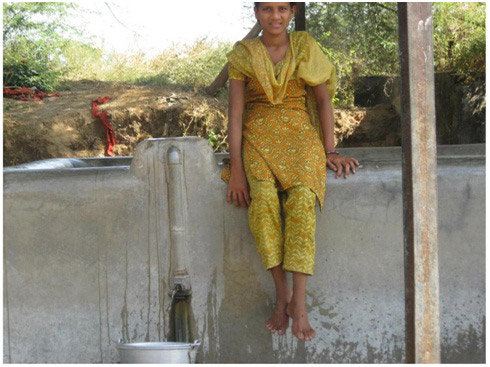

Common Washing Places
Waste management:
I. Solid waste:
(a) Domestic Solid waste management: As such, no method exists for solid waste management in the village. People dispose the waste on any open land. A common place to dump the waste has automatically come in to existence; people staying nearby the place use the same for dumping the waste.
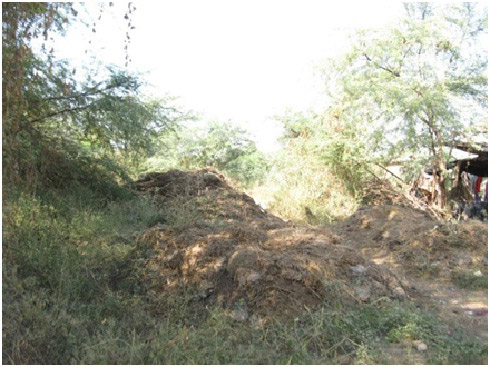
Common place to dump solid waste
(b) Live stock waste: It is generated at almost every household. People generally collect and send them to nearby agricultural fields for soil conditioning and to use as fertilizer. Sometimes some external agencies also buy the dung waste for various purposes.
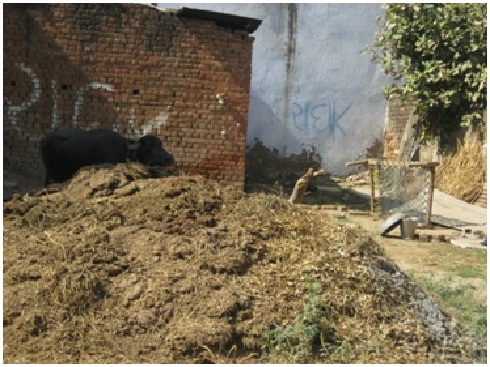
Dung waste
II Liquid Waste:
Disposal of liquid waste is the most neglected aspect in village Tintoda. As it has been stated earlier, only 25% of required drainage system is employed in the village. The grey water from drainage system is directly discharged in to a nearby lake without any treatment. All liquid wastes from households is discharged on nearby open land. Only 10% population has availed sanitation facilities. So the fate of waste water and hence that of village inhabitants is uncertain.
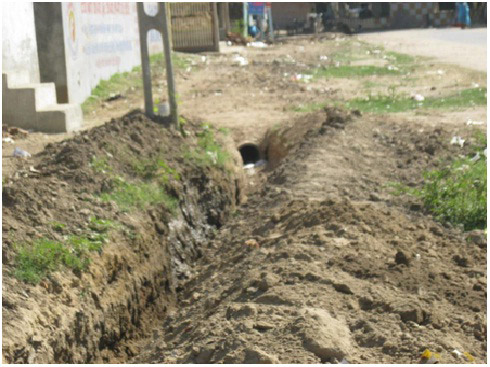
Drainage system connecting to common washing place
Sanitation:
Village undergoes a severe problem of less sanitation infrastructure. The community is comparatively poor here and literacy level is low, so the most important part of human hygiene has been totally ignored here. Only 10 % population has sanitation facilities. Open defecation is very common across the village people.
Summary:
Village Tintoda can be characterised, especially with a view to environmental management as follows:
1. The economy of the village is based on agriculture and cattle rearing. Village has more than 3000 bovine animals, but cattle do not play any important role in improving overall economy of the village.
2. Village does not have any systematic waste management system for solid as well as liquid waste. Only 25% of population has amenity to drainage system.
3. Only 10 % population is served with sanitation infrastructure like bathroom and WC. Open deification is a common practice here leading to problems related to hygiene, aesthetics, society and culture.
4. People are struggling to meet the basic needs of day-to-day life. Most people do not generate domestic waste, just because they do not get enough to sustain their daily lives.
5. Major part of the population has access to water supply and electricity.
Quantity of waste generation at village Tintoda
| Sr. No. |
Type of waste | Quantity/capita/day | Total Quantity |
Present W/M practice |
| 1 | Domestic solid waste | 100 gm/capita/day Population=7000 |
700 kg/day | food waste-cattle feed Others- Recycling, selling to vendor, dumping in open place |
| 2 | Cattle dung | 10 kg/capita/day No. of cattle= 3000 |
30000 kg/day |
unorganized practice of dumping the dung in fields |
| 3 | Agricultural waste | — | 31.3 ton/day | dumping, transporting the waste to nearby city area |
| 4 | wastewater | 100 lit/capita/day Population=7000 |
700 m3/day | No system exists, open discharge |
Proposal for waste management plan
On the basis of above stated observations, system of waste- cum- resource management is suggested mainly on following line of action:
I. Solid waste shall be separated at source as biodegradable and non-biodegradable. Non-biodegradable waste shall be sent at local material recovery and recycling centre.
Biodegradable waste shall be meticulously collected and sent to community biogas plant. As per the guidelines of MNRE, biogas enrichment and power generation unit shall be constructed.
II. For liquid waste, whatever drainage facility is available shall be continued to utilize, and at the end point of disposal, conventional wastewater treatment shall be carried out. The treated water shall be reused according to the present need, e.g. vegetation and irrigation. Treated water can be utilized for preparing slurry at community biogas plant.
IV. Those, who own their farms and stay away from the village can opt for private compost sanitation system that produces compost at the interval of each 3 to 4 months on regular basis.
V. Cost – benefit analysis and carbon credit statement, compatibility to legislation of Government of India and further procedure shall be carried out.
DETERMINATION OF FEASIBILITY OF THE PROJECT
Determination of feasibility for a waste management project is strongly founded on following three aspects which are discussed in Agenda 21- UN as sustainability pillars: (I) Economy (II) Environment (III) Society. In such particular cases where environment and society are 100 % benefitted, analysis of feasibility results becomes contextual.
Economy
It is further classified in to two sections broadly: (A) Assessment of cost for the implementation of the proposed project (B) Assessment of benefits by the implementation of the proposed project
Assessment of cost for the implementation of the proposed project
Estimated capital cost of the proposed project
| Sr. No. | Particulars | Qty | Rate | Cost |
| D-I | Cow dung based biogas plant with upgrading and bottling units | |||
| 1 | Digester Incl.gas holder & balancing tank | 4 Nos | 675000=00 | 2700000=00 |
| 2 | Plant room Incl platform & mixing tanks | 4 Nos | 175000=00 | 700000=00 |
| 3 | high pressure water scrubber | 2500000=00 | ||
| 4 | Power gen cost | 2.02 Rs/kwh | 3000000=00 | |
| 5 | Water supply | 200000=00 | 200000=00 | |
| 6 | Electrification | 200000=00 | 200000=00 | |
| 7 | Gas pipe, Scrubber stove etc | 30000=00 | 30000=00 | |
| 11 | Other costs- gas storage tanks/land preparation | 800000=00 | 800000=00 | |
| 12 | Composting units with farm sheds | 6 Nos | 150000=00 | 900000=00 |
| D-2 | Agro waste briquette machinery | 14000000=00 | 14000000=00 | |
| D-3 | Waste water treatment system | |||
| Screen chamber | 20000=00 | |||
| Grit chamber | 4500=00/m2 | 198000=00 | ||
| Sedimentation tank | 4500=00/m2 | 108000=00 | ||
| UASB | 6000=00/m3 | 990000=00 | ||
| RBC | ||||
| Plastic discs | 30=00/m2 | 280000=00 | ||
| steel shaft | 55=00/kg | 10388=00 | ||
| Tank | 4500=00/m2 | 810000=00 | ||
| Gas connections and pipelines | 500000=00 | |||
| Total Project Cost | 27217338=00 |
Estimated cost of Operation and maintenance
| Sr No. | Particulars | Cost | Remarks |
| 1 | Total waste management project | 544346=00 | 2% of Capital Investment amount Per annum |
| 2 | Gobar bank | 2874375=00 | 0.35Rs/kg dung |
| 3 | Agro waste | 3310800=00 | Rs 300/ton |
| 4 | Salary and wages | 1000000=00 | Per annum |
| Total | 7729521=00 | Per annum |
Estimated cost of Dissemination and soft core management
| Sr No. | Particulars | Cost | Remarks |
| 1 | Mass communication through media, newspaper, posters, wall painting |
1000000=00 | On DD India channel |
| 2 | Trainings and meetings | 200000=00 | Per annum |
| 3 | Identification of and communication with stakeholders |
150000=00 | Per annum |
| 4 | Stationary | 50000=00 | Per annum |
| 5 | Others | 50000=00 | Per annum |
| Total | 1450000=00 | Per annum |
Total Cost:
Investment: (a) Rs 27217338=00= 00
Running Cost: {(b) + (c) } = { 7729521=00 + 1450000} =Rs 9179521=00 per annum
Assessment of benefits by the implementation of the proposed project:
Revenue Generation
| Particulars | Quantity | Rate | RG PA | |
| 1 | Power generation | 5 MWh daily | 5 rs /kwh | 9125000=00 |
| 2 | Vermi compost manure | 3840 kg/day | Rs 5/kg | 7008000=00 |
| 3 | Gas connection to household |
220 families | Rs 150 /family/month |
33000=00 |
| 4 | Agro waste briquetting | 11036.93 T/annum |
Rs 3000 / T | 33110790=00 |
| Total | 49276790=00 |
Total Revenue Generation: Rs per annum= 49276790=00
Environment
Following attributes of environment are influenced positively by application of the proposed waste management plant:
(a) Reduction in GHG emission (b) Water reuse (c) Deforestation (d) Soil Enrichment (e) Public health & hygiene
(a) Reduction in GHG emission: (CO2) emission
Reduction in CO2 emission
| Sr. No. |
Activity | CO2 emission Kg/kg fuel |
Particulars- Replaced with biogas |
Total CO2 emission reduction Per Annum kg |
| 1 | Burning of wood |
1.83kg/kg | 220 families × 5 = 1100 Nos |
1.83×147×1100=295911.00 |
| 2 | Electricity | 0.88 kg/kwh coal fired PP |
5 MW/day PG through biogas |
1.606×106 kg |
| Total | 696425.10 |
(b) Water pollution
Waste water generation= 100×7000= 700000lit/day= 255500 m3 per annum Hence, with sewage treatment plant 255500 m3 water will be available for reuse. It will reduce BOD= 400 mg/l ×365= 146000mg/l per annum
(c) Deforestation
Per capita annual consumption of fuel wood in Gujarat= 147 kg
Saving of fuel wood= 147×1100 = 161700 kg per annum
(d) Soil enrichment
Vermicompost adds nutrients to soil. Ratio of N:P:K in well maintained vermicompost is 2:1.5:1 in percentage.
Hence, it can be calculated as
Total Nitrogen = 2% of total manure produced: 28032 kg per annum
Total Phosphorus= 1.5% of total manure produced: 21024 kg per annum
Total potassium = 1 % of total manure produced: 14016 kg per annum
(e) Public health and hygiene:
(i) The plan proposes to treat 700000 lit/day that will have definite impact, on positive note, upon health scenario. Water borne diseases will start eliminating with wastewater treatment. It will also decrease breeding of mosquitoes on stagnant untreated water.
(ii) It has been proposed to install biogas plant with gas enrichment unit based on cattle dung that was being dumped in open place.
The following are the principal organisms killed in biogas plants:
o Typhoid
o Paratyphoid,
o Cholera and dysentery bacteria (in one or two weeks),
o Hookworm and bilharzia (in three weeks).
o Tapeworm and roundworm die completely when the fermented slurry is dried in the sun.
(iii) The plan proposes to generate 220 cu m/day biogas for cooking purpose. That will significantly reduce all the hardships need to be undergone by people to use firewood as fuel. It will save 11×220 = 2420 hrs/week of the manpower that can be utilized effectively in other constructive jobs and it will definitely improve health conditions of the beneficiaries.
(iv) Plan also proposes various ways to generate income and employment opportunities for the habitats. Raised economical level will bring more hopes in an individual’s life.
Schematic diagram of waste management plan for village- Tintoda
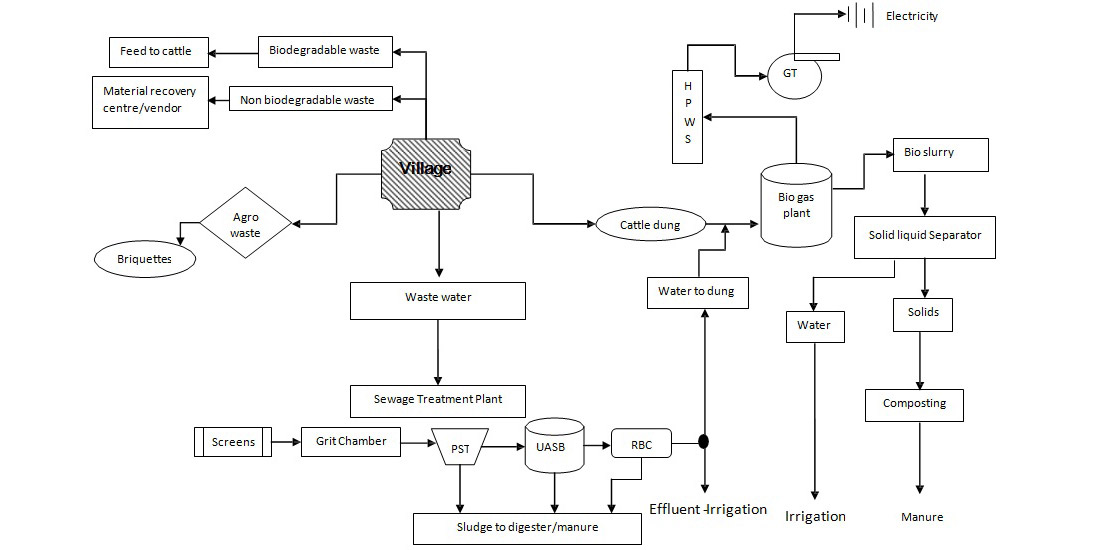
CONCLUSION
Tintoda is a village with population of 7000 people. Following waste management plan is suggested for the village:
WM summary
| Sr. No. |
Type of waste | Quantity/capita/day | Total Quantity |
WM Solution |
| 1 | Domestic solid waste | 100 gm/capita/day Population=7000 |
700 kg/day | cattle feed |
| 2 | Cattle dung | 10 kg/capita/day No. of cattle= 3000 |
30000 kg/day |
Biogas plant with enrichment unit and power generation installations |
| 3 | Agricultural waste | — | 31.3 ton/day | Briquette from agro waste |
| 4 | Wastewater | 100 lit/capita/day Population=7000 |
700 m3/day | Sewage treatment plant |
[A] Biogas plant with enrichment unit and power generation installations
Following are the characteristics of the proposed biogas plant:
• Cattle dung based biogas generation plant uses about 22500 kg cattle dung per day to generate 1080 m3/day biogas.
• The plant mainly consists of four anaerobic digesters mounted in parallel, high pressure water scrubber and gas turbine. The plant has capacity to generate 5 MW power which is suggested to be supplied to main state power grid.
• It produces manure of 3840 kg/day through vermin composting process.
• It produces liquid fertilizer about 200 m3 which is nutrient rich.
[B] Agricultural waste
• Village Tintoda owns 805.1137 hectares cultivable land area. Effective irrigated land area is 374.68 hectares. Total crop production of all three seasons is 11500 T/annum and waste produced from the same is 12140.625 T/annum.
• The waste is used in making the briquettes which can be used as an alternative fuel especially wherever coal is used as fuel. The quantity of briquette from agro waste is 11036.93 T/annum.
[C] Waste water from sewage
• The quantity of wastewater generated from the village is 700 m3/day. It is suggested to treat the water through sewage treatment plant. The plant comprises of primary and secondary treatment units, which results in effluent with TSS
• For secondary treatment UASB is used which produces 221 m3 of biogas. It is suggested to distribute biogas to village people for domestic cooking use through pipelines.
The waste management plan described above provides sustainable solution, satisfying three criteria of sustainability: (a) Economy (b) Environment (c) Society. It generates a pretty good amount of revenue, reduces CO2 emissions, creates opportunity for employment and brings positive change in lives of farmer and other inhabitants of the village.
With the changing trends, attitude of rural people is directing towards awareness. This awareness can play a key role in successful implementation of waste management projects founded on renewable energy principles. Earlier scenario of unsuccessful attempts of running biogas plants can be easily forgotten as a major shift is seen in the society in the process of understanding the inclusive growth. The hurdles in running the plants were majorly at people level and not at the technological level. Only lack of discipline, trust and motivation were the main culprit for the failure. But government, along with more and more entrepreneurs has started to set the examples expressing spherical thinking instead of linear thinking. Progress is the obvious result of this “dung deal”.
REFERENCES
Abou Shaban D. Hussein and Sawan Omaima M., The Utilization of Agricultural Waste as One of the Environmental Issues in Egypt (A Case Study)
Benjes Henry H, Small community wastewater treatment facilities Biogas digest- GTZ Volume II
Biomass briquetting in Sudan- A feasibility Study by Dr. Ahmad Hassan Hood biogas for rural community- vaibhav nasery www.cse.iitb.ac.in
DEWATS- in developing countries- Ludwig sasse- BORDA
Dr. Mapuskar S V. , Technologies for liquid waste management in rural areas
Dr. Tare Vinod, Solid-Liquid Waste (Residue) Utilization and Way Towards Zero discharge Dr. Majumder Arunabha, Rural solid waste management: Issues and actions
Dr. R. Ajayakumar Varma, Status of solid waste generation in Kerala and their characteristics Dr. ready Akepati S- Biological treatment
Daniela Jölli and Stefan Giljum- Sustainable Europe Research Institute (SERI) Unused biomass extraction in agriculture, forestry and fishery
Directorate of Census Operations Gujarat www.censusindia.gov.in
Economic analysis of options for managing biodegradable municipal waste: Final report to European commission, by ECOTEC research and consulting
EPA Manual Wastewater Treatment/Disposal for small communities
Er. Seshadri Ajit , Decentralized Wastewater Management – An overview of community initiatives
General Standards for effluent treatment- CPCB- India www.cpcb.nic.in/GeneralStandards.pdf
Handbook on Community Sanitation system www.indiasanitationportal.org Indian Biogas Association- www.biogas-india.com
Ministry of Health and Family Welfare. Family welfare statistics in India–2006
www.mohfw.nic.in
Modified guidelines on specifications, standards, unit costs, O&M protocols, subsidy norms and contract conditions for solid waste treatment plants to be set up or promoted by local governments using vermin composting, windrow composting and bio-methanation technologies.
(GO(MS) No. 73/2011/LSGD; dated 01-03-2011Govt of Kerala- India
http://sanitation.kerala.gov.in/docs/orders/go_on_modified_guidlines.pdf
Manual on sewerage and sewage treatment- The Government of India
http://urbanindia.nic.in/publicinfo/manual_sewage.htm
Mtcalf-eddy Wastewater Engineering
Navrekar Shrikant M.,Sustainable solid waste management- Need of the hour
Paper on Environmental, Socio economic, health and other positive impacts of building household biogas plants in Rural India- Raymond Myles www.indesa.org
project design document, 4 MB waste based power generation project- Vensa biotek limited-Andhrapradesh http://ebookbrowse.com/andhra-pradesh-vensa-biotec-pdd-pdf-d42166185
Publication by LGED- Bangladesh on design of biogas plant based on information collected from Biogas Training Centre- Chendu, China www.lgedrein.org
Shah Mayur C., Shilpakar Prateek G. and Acharya Pradip B. -Ground Water Quality of Gandhinagar Taluka, Gujarat, India
Success stories on Gujarat Sanitation- Dept of Rural development- Govt of Gujarat
Simplified sewerage manual www.efm.leeds.ac.uk-
Toshniwal P.L. and Singh Ranjeet, Self Sustainability and Employment Generation with Cow and Its Progeny
TSC guidelines- GOI
Daniela Jölli and Stefan Giljum- Sustainable Europe Research Institute (SERI) Unused biomass extraction in agriculture, forestry and fishery –
Varshney A. C. – Rural waste management
Virendra K. Vijay, Parchuri Ram Chandra, Subbarao M. V.and Kapdi Shyam S.- Biogas Purification and Bottling into CNG Cylinders: Producing Bio-CNG from Biomass for Rural Automotive Applications
www.excellentrenewables.com
www.mnre.gov.in
www.pura.org.in
www.sulabhinternational.org
www.un.org
www.ddws.gov.in
www.mapsofindia.com
www.wikimapia.com
www.agricultureinformation.com
www.realtechbriquettingmachines.com
www.realtechbriquettingmachines.com
Total Waste Management in Rural Sector of India- proposed waste management plan for Village Tintoda-Dist. Gandhinagar-Gujarat
